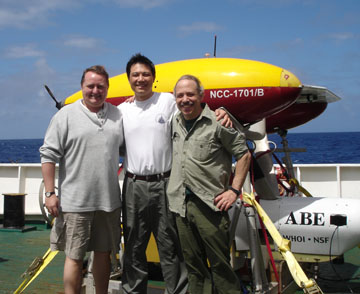InterRidge China Update: Chinese Research Cruises Discovered the First Active Hydrothermal Vent Field at the Ultraslow Spreading Southwest Indian Ridge
Two recent Chinese research cruises on board Chinese R/V DayangYihao have successfully discovered the first active hydrothermal vent field at the ultraslow spreading Southwest Indian Ridge and collected hydrothermal sulfide deposit samples from the vent sites. The newly discovered hydrothermal vent field is in the central eastern portion of the Southwest Indian Ridge and is located on the western end of a magmatically robust spreading segment. These cruises were funded and sponsored by the China Ocean Mineral Resources R & D Association (COMRA) and were conducted on the 105-meter-long R/V DayangYihao.
The first direct color video footages of the active hydrothermal vent field were obtained by a deep-towed video camera on February 7, 2007 during the Leg 1 of the COMRA DY115-19 expedition. This new vent field was then extensively photographed and surveyed in great details in late February-early March during the subsequent Leg 2 of the DY115-19 expedition using the Autonomous Benthic Explorer (ABE) of the Woods Hole Oceanographic Institution (WHOI). More than 5,000 near-bottom color photos were taken and several types of water column data were recorded during three phases of ABE dives, revealing detailed seafloor geology, water column anomalies, and ecological features. Within the approximately 120-m-long by 100-m-wide hydrothermal vent field, three groups of active hydrothermal vents were identified and color images of black smokers and ecological community were obtained by ABE flying 5 m above the seafloor. Hydrothermal sulfide deposits were then successfully obtained from the newly discovered vent sites using COMRA’s TV-guided grabber.
During the Leg 1 of the DY115-19 expedition in February 2007, the Chinese science party on board R/V DayangYihao conducted extensive water column surveys using MAPR, CTD, and other sensors and measured major water column turbidity anomalies (up to 3.8 volts), noticeable temperature anomalies (up to 0.2°C), as well as methane anomalies. The first signs of strong water column turbidity anomalies in this part of the Southwest Indian Ridge were discovered in November 2005 by MAPR instruments installed above a Chinese deep-tow vehicle during the Indian Ocean leg of the COMRA-sponsored first modern Chinese around-the-globe expedition (see InterRidge News, vol. 15, pp. 33-34, 2006).

Abe on the deck of the R/V DayangYihao. Chris German, Jian Lin and Dana Yoerger.
The 2005 and 2007 multi-leg Chinese research cruises to mid-ocean ridges are funded by COMRA (http://www.comra.org). COMRA was established in 1991 and overseas China’s national programs of deep-sea research, exploration of new ocean mineral resources, and development of new technologies for deep-sea research. Scientists and graduate students from more than 20 Chinese research institutions and universities have participated in various legs of the 297-day-long around-the-globe expedition in 2005, conducting researches in the central Pacific, East Pacific Rise, Mid-Atlantic Ridge, Southwest Indian Ridge, and the Central Indian Ridge. A large number of Chinese scientists and students are also involved in the on-going 2007 multi-leg cruise, which conduct researches at all the three ridges in the Indian Ocean, the Lau Basin, and the Pacific Ocean. COMRA encourages international cooperation and has hosted international scientists in its cruises. Several US and German scientists had participated in the East Pacific Rise and Indian Ocean legs of the 2005 cruise. During the recent Leg 2 of the DY-115-19 expedition, the Chinese science party under the leadership of Chief Scientist Chunhui Tao has collaborated well with a five-member WHOI team (Jian Lin, Chris German, Dana Yoerger, Al Duester, and Andy Billings) in conducting the successful ABE dives at the Southwest Indian Ridge.
The recent discovery of the first active hydrothermal vent field at the ultraslow spreading Southwest Indian Ridge is an important event for researches of the geological, hydrothermal, and biological processes of the Indian Ocean and ultraslow spreading ridges. This is also the first time that an active hydrothermal vent field was discovered by Chinese research cruises on board a Chinese research vessel, a milestone event in Chinese programs of ocean research and exploration of ocean mineral resources. It reflects China’s increasing contributions to international ridge research since China became an InterRidge associate member nation in late 2003. It is anticipated that China will play an increasingly important role in mid-ocean ridge research and exploration in the coming years and will continue to strengthen its cooperation with the InterRidge program and the international community.
Correspondence: Y. John Chen, InterRidge China Office, Institute of Theoretical and Applied Geophysics, School of Earth and Space Sciences, Peking University, Beijing 100871, China; 86-10-6275-8277; johnyc@pku.edu.cn




